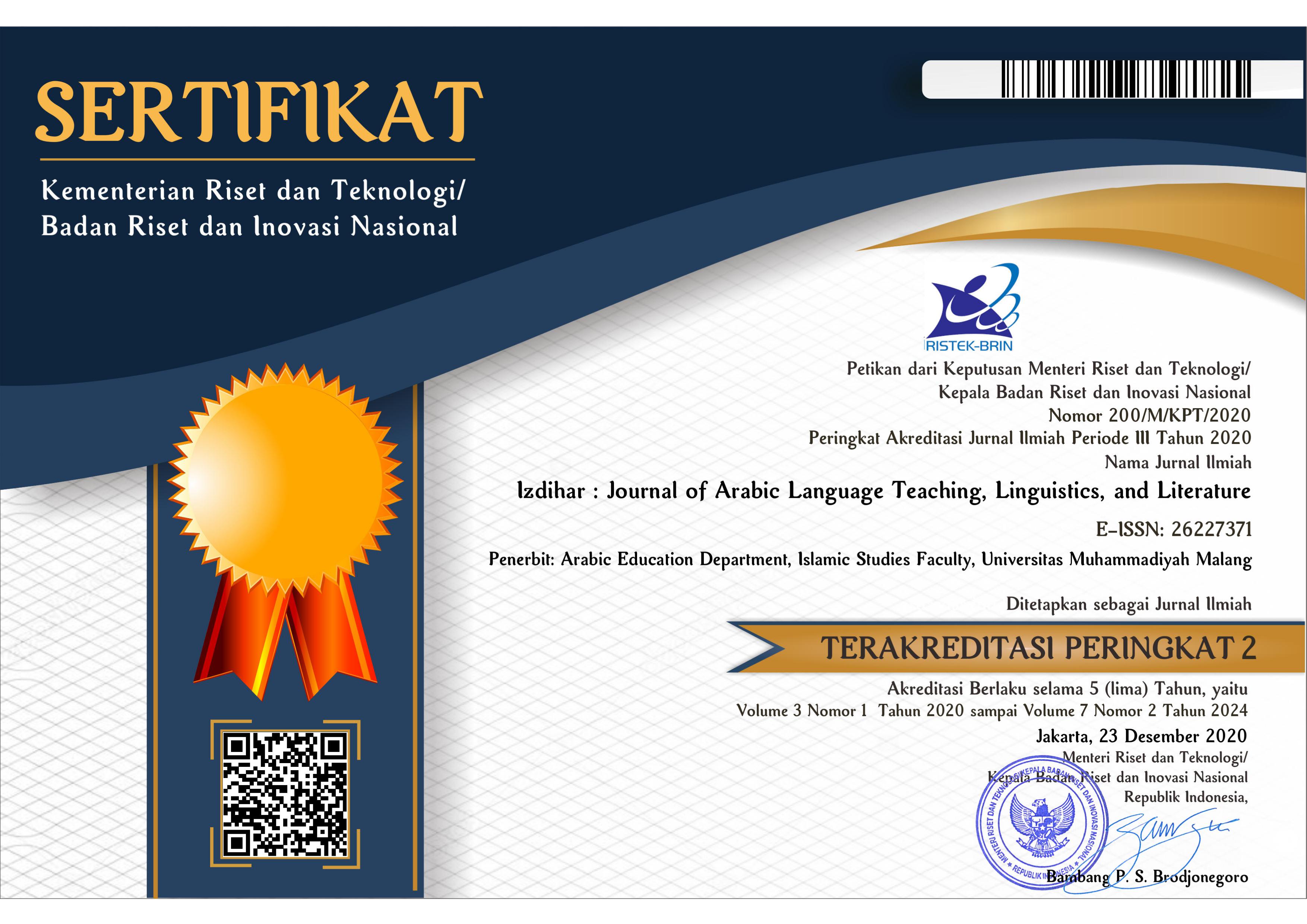Analysis of Pierce's Semiotic Perspective in the Terminology of Nahwu
DOI:
https://doi.org/10.22219/jiz.v5i2.17238Keywords:
Pierce's semioti; terminology of NahwuAbstract
This research is motivated by many Arabic Language students who only understand the terms of grammatical function in Nahwu, yet not with the essence of its meaning. Therefore, this research researches one of the books in the past - that keeps much secret knowledge - with semiotic studies as part of the linguistic form and educational value analysis. The purpose of the research is to recognize the icons, indexes, and symbols that had been used by Imam Ibnu Ajibah as the interpretation of terms in Nahwu and to know the value of education in this book. The research method that is used is qualitative descriptive with Pierce semiotic approach and literature review technique for research data collection. This research's primary data source is from Al-Futuhaat Al-Quddusiyah Fi Syarhi Muqaddimati Al-Jurumiyyah book created by Imam Ibnu Ajibah. The result of this research shows that there are two icons in the book: Tasawuf/Sufism (teachings on how to get closer to Allah and be united with Him) expert and the second one is what Sufi people do. Three indexes are also recognized: the speaking behavior index, behavior of a Salik index, and jihad behavior index. The six symbols inside the book are the Asma Allah symbol, the procedure of the Wushul symbol, the Ma'rifat symbol, the saints' oath symbol, the Jihad symbol, and the unseen symbol. The value of education in the book includes tawhid education values - which are Rububiyyah Tawhid and Asma wa Sifat Tawhid - and moral education values - which are morals towards Allah, Rasulullah, and morals towards human beings in their personal and social environment state-.
Downloads
References
Ajibah. (n.d.). Al-Futuhat al-Qudsiyah fi syarhi al-muqaddimah Al-Jurumiyah. Saudi Arabia: Jami’ah al-Malik Su’ud.
Bahreisy, H.S (Penerjemah). (1980), Terjemah Al-Hikam. Balai Buku
Dukes K., Atwell, E. & Habash, N.. (2013). Supervised collaboration for syntactic annotation of Quranic Arabic. Springer: Language Resources and Evaluation, Vol. 47 (1), 33-62. DOI: https://link.springer.com/article/10.1007/s10579-011-9167-7
Jailany, S. (1973). Futuhu al-ghaib. Sirkah Maktabah
Jailany (1993). Sirru al-asrar. Maktabah al-Jailany Dar al-Sanabil
Kurdi. (1333 h) Tanwir al-qulub fi mu’amalai allamu a-ghuyub. Sirkah al-Nur
Luqoni, D.U. & Kamal, D. (Penerjemah). (2005). Huruf-huruf magis. PT LKIS Pelangi Aksara.
Maharani, N. (2017). Tafsir al-isyari. Hikmah, Vol. 14(1)
Mujib, F. (2010). Rekonstruksi Pendidikan Bahasa Arab. PT Bintang Pustaka Abadi (BiPA)
Nasution, S. (2016). Ithqan Maharat al-Lughah al-'Arabiyah Min Khilal Tadris al-Nahw. Arabi: Journal of Arabic Studies, 1(2), 102-114. https://doi.org/10.24865/ajas.v1i2.5
Pradopo, R.D. (1999). Semiotika: Teori, Metode dan Penerapannya dalam Pemaknaan Sastra. Jurnal Humaniora, Vol. 11(1), 76-84. DOI: https://doi.org/10.22146/jh.v11i1.628
Qusyairy (n.d.). Nahwu al-qulub. Dar al-Kutub al-Ilmiyah.
Sauri, S. (2013). Filsafat dan teosofat akhlak. Genesindo
Sobur, A. (2016). Semoitika komunikasi. PT Remaja Rosdakarya
Sukarnawadi, A.A. (2011). Tata Bahasa Sufi: Mengungkap Spiritualitas Matan Jurumiyah. PT. Setia Murni Amanah
Sumarna, L. (2019). Kajian Semiotik atas Nahw al-Qulub Karya al-Qushayry (w.465/1072). Disertasi: Tidak diterbitkan
Mahmood, T., & Ya’qub, M. (2016). al-Lughah al-’Arabiyyah wa Makanatuha al-’Ilmiyyah fi Fahm al-Qur’an wa Tafsirih. Al-Qisam Al-Arabi, 23 (2), 45–68.
Zakiyah. (2012). Kitab Al-Sanī Al-Maṭālib: Interkoneksi Nahwu dan Tasawuf.
Walisongo: Jurnal Penelitian Sosial Keagamaan, 20(2), 2012, 371-390.
Downloads
Published
How to Cite
Issue
Section
License
Copyright (c) 2022 Asep Sopian; Settings Al-Rawafi Abdulkhaleq; Izdihar : Journal of Arabic Language Teaching, Linguistics, and Literature

This work is licensed under a Creative Commons Attribution-ShareAlike 4.0 International License.
Copyright Notice
Authors who publish with this journal agree to the following terms:
- Authors retain copyright and grant the journal right of first publication with the work simultaneously licensed under a Creative Commons Attribution-ShareAlike 4.0 International License that allows others to share the work with an acknowledgment of the work's authorship and initial publication in this journal.
- Authors are able to enter into separate, additional contractual arrangements for the non-exclusive distribution of the journal's published version of the work (e.g., post it to an institutional repository or publish it in a book), with an acknowledgment of its initial publication in this journal.
- Authors are permitted and encouraged to post their work online (e.g., in institutional repositories or on their website) prior to and during the submission process, as it can lead to productive exchanges, as well as earlier and greater citation of published work (See The Effect of Open Access).
Copyright (c) 2019 Izdihar : Journal of Arabic Language Teaching, Linguistics, and Literature

This work is licensed under a Creative Commons Attribution-ShareAlike 4.0 International License.

















